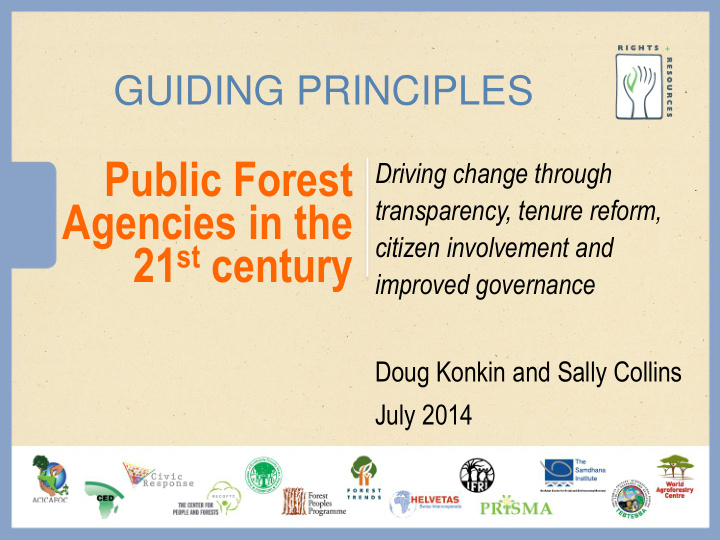



GUIDING PRINCIPLES Public Forest Driving change through transparency, tenure reform, Agencies in the citizen involvement and 21 st century improved governance Doug Konkin and Sally Collins July 2014
MegaFlorestais 2014, Buea 2 FORESTS IN THE FUTURE--EXPECT: - Decrease in natural forests in the tropics and expanded forests in the boreal zone. - More frequent fires, pests, droughts and related climate disturbances. - Expanded investments in mining, agriculture and energy development cutting through the remaining natural forests. - Younger, simpler in structure, and more fragmented forests. - Increasing loss of species and biodiversity - Increasing impact from invasive species and encroaching ecosystems - Unknown compounding effects
As a result… 3 Forest and grassland ecosystems will be much more difficult and costly to manage . Forest products will be less predictable, affecting the potential supply to markets, employment, the livelihoods of local people, and revenues to governments.
Introducing: Five Principles 4 • Essential principles to guide the future of effective forest governance in the twenty-first century that apply. • Regardless of institutional age, organizational structure and even the political system in which forest agencies operate.
Principles: 5 • Transparency in government is essential. • Clarification of tenure (land rights and ownership) is a key priority for government. • Inclusive government is necessary. • Forest agencies must evolve. • Forest leaders must acquire new skills.
1. Transparency 6 Possible strategies for public forest agencies to take the lead in increasing transparency in government: • Make forest data free and easily accessible. • Involve citizens in the planning & implementation of forest policies and regulations that affect them. • Ensure bidding for forest products from publicly held forests is done in a fair, open and competitive manner. • Increase the ability of community groups and other stakeholders to actively monitor the performance of the agencies that serve them. • Engage citizens in effective and productive ways .
2. Clarification of tenure (land rights & 7 ownership) Possible strategies for public forest agencies to take the lead in land rights and ownership: • Willingly partner in or lead policy changes on forest tenure. • Advocate for clarification of tenure as an essential step in advancing human rights, alleviating poverty, and preserving forests. • Work quickly to enable people to take advantage of new rights and tenures. • Help lead the transformation of forestland ownership and tenure by……?
3. Inclusive governance 8 Possible strategies for forest agencies to actively engage stakeholders: • Use technology to reach citizens, even in remote areas • Develop regulations that are readily understood, implemented and enforced • Engage forest users in monitoring & enforcement • Establish effective citizen/stakeholder advisory processes to incorporate wide-ranging perspectives • Actively engage private land owners, Indigenous Peoples & local communities early in policy development and execution . • Be accountable
4. Ability to evolve 9 Possible strategies for public forest agencies to take the lead in improving governments ability to respond to citizen demands, changes in forests and global trends: • Be open to new approaches and organizational models that increase the ability of government to make integrated decisions. • Encourage policies at the regional or landscape scales. • Help resolve conflicting policies by advocating for joint processes to review and create policies. • Produce superior results.
5. A broader skillset for forest leaders 10 Possible strategies for public forest agencies to take the lead in helping resource managers and leaders hone and acquire the skills necessary to be successful: • Create an inclusive culture within agencies by learning to (really) listen to citizens and active social/community engagement. • Create a deeper understanding of global trends • Target appropriate skill development for future forest leaders • Work with teaching institutions to modernize curriculum.
The Road Ahead 11 • Public forest agencies should use and value their convening power. • Especially to: 1.Proactively engage other land-based ministries or private sector actors, 2.Ensure that rational and transparent decisions on land and land use are made, 3. Make sure citizens’ rights are protected. • Leaders must set ambitious goals and lead their organizations and political leaders towards these goals.
Conclusion 12 • Unprecedented changes are on their way. • Forest agencies have 2 choices: they can positively influence this future or be casualties of it. • Let’s all work together, learn from our successes and failures to figure out the way forward.
Authors 13 • Tasso Azevedo (Brazil) • Sally Collins (US) • Juan Manuel Torres-Rojo (Mexico) • Doug Konkin (Canada) • Pak Boen (Indonesia) • Keshav Kanel (Nepal) • Jim Farrell (Canada) • Dale Bosworth (US)
Recommend
More recommend